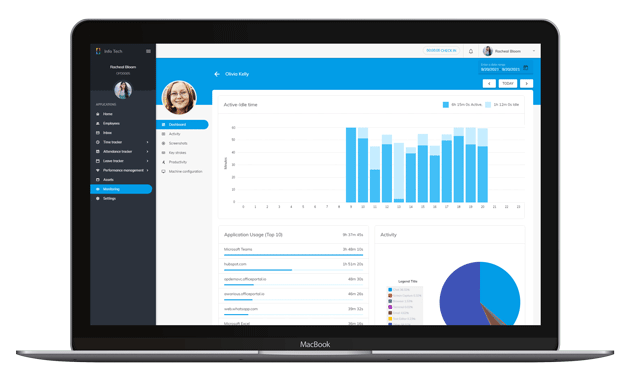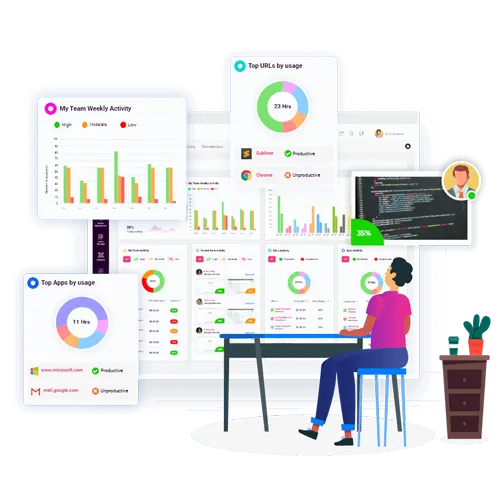The term "employee monitoring software" refers to an application used by organizations to track and monitor the activities of their employees as they work. It permits employers to collect information on different aspects of employees' behavior like internet use applications, keystrokes, app usage, and even screen shots. The main purpose behind employee monitoring software is to increase productivity, make sure that employees are in compliance with company policies, safeguard sensitive information and address security concerns. When choosing an employee tracking software, there are many things to consider. Here are the most important things to remember to consider: Features- Choose which features your organization needs based on its requirements. Features include monitoring email, activity monitoring, blocking websites and keystroke recordings and tracking the usage of applications, and email monitoring. You should prioritize only those features that are pertinent to your monitoring requirements.
Privacy and Compliance: Make sure the software complies with the ethical and legal guidelines for monitoring employees. Find out about the laws, regulations and laws in your region. Search for software that has clear and customizable settings that ensure that privacy rights of employees are respected.
User-Friendliness: Consider the software's accessibility and user-friendliness. Simple installation and a simple interface will simplify the implementation and will save you time. Look for customizable dashboards with intuitive reporting tools, as well as other features that let you to quickly navigate and interpret collected data.
Integrity and Compatibility- Ensure that the software integrates smoothly with your current IT infrastructure and with the systems you use including operating systems and email clients, as well as tools for managing projects, and collaboration platforms. Software that is compatible ensures continuous monitoring, and doesn't interfere with your day-to-day business.
Data Security: Evaluate the security measures of the software to ensure protecting the information collected. Access controls as well as encryption and secure storage of data, and conformity to industry-standard security protocols are essential. Check that the software company is recognized for its data security track record and has strong security measures.
Scalability- The software should be capable of scaling up and down according to the growth of your business. Select a program that can easily scale up to meet the requirements of your business if you are planning on expanding your workforce or opening new locations.
Reporting and Analytics- Assess the reporting capabilities of the software. Find features that provide detailed information about employee productivity and the allocation of time. Customized reports and analysis will assist you in making educated decisions, and identify areas for improvement.
Customer Support: Assess the level of customer support offered by the software vendor. Examine their responsiveness, accessibility and the amount of technical assistance they provide. If problems arise, a good customer service ensures that you get quick assistance.
Cost- Take a look at the pricing model of the software, regardless of whether it's a one-time fee or subscription-based. Understanding the pricing structure and the additional costs, such as support, updates or additional features is crucial. Be aware of the features and costs of every product.
Transparency and Employee Communication Be clear with your employees regarding the implementation of software for monitoring. It is important to clearly define the goals and scope, as well as expectations and limitations of monitoring. Discuss any concerns they might have and make sure they understand how privacy will be protected.
Take note of these aspects to make an the right decision and choose the employee monitoring software that can meet your business' standards while also respecting the employee's privacy. Read the most popular time tracking monitoring software for more recommendations.

What Are The Functions Of Software For Employee Monitoring?
Software for employee monitoring offers various features that can be utilized to monitor and analyze the behavior of employees. The software for monitoring employees may include different options. Here are a few most commonly used ones. Activity Monitoring The feature tracks and logs all employee activities such as the websites visited, applications utilized, files accessed, and the time spent. It gives a comprehensive analysis of how employees spend their time.
Keystroke Logging: Keystroke logs record every keystroke performed by employees. It is a way to identify productivity bottlenecks as well as detect unauthorized actions and collect evidence to aid investigations.
Screenshots & Screen Recordings- Certain programs can take screen captures or record screens of employees on a regular basis. This feature can be useful in monitoring employee productivity, verifying compliance or troubleshooting problems.
Internet Usage Tracking: This feature monitors the internet activities of employees such as the websites visited, queries and downloads. It can be used to detect excessive browsing that is not related to work, security risks, or violations.
Application Usage Tracking: This feature is used to track which apps employees use during working hours. It offers insight into which apps are the most often used, and can help determine any inappropriate or unapproved use of the application.
Email Monitoring - Email monitoring allows employers monitor employee emails that include received and sent messages, as well as email content. Employers can ensure compliance with policies as well as to stop data leaks and to investigate suspicious activities.
The tracking of documents and files This feature lets you monitor changes to files as well as access and transfers. It helps protect sensitive data and monitor collaboration between documents and make sure that data security is in compliance with policies.
Remote Monitoring allows employers to monitor employees that work remotely or at different locations. Employers are able to observe employee activity and monitor the productivity of employees, no matter where they are.
Productivity Analysis Software used to monitor employee performance often comes with productivity analysis features that provide information on employees' time allocation and patterns of work. These analyses permit the analysis of areas that can be improved, and also help to optimize workflow.
Analytics and Reporting- Robust tools for reporting and analytics generate detailed reports based on the information that has been collected. These reports offer valuable insight into the performance of employees as well as resource allocation and time management.
Compliance and Policy Management- Some software solutions have features that help ensure compliance with regulations of the industry and company rules. The software allows employers to define and enforce guidelines regarding acceptable use of computers, Internet access, and data safety.
Alerts and notifications - Alerts or notifications alert employers or managers of specific situations or actions. They can, for example notifying managers or employers about certain activities or events that occur.
These features are available in different software options for monitoring employees. When selecting a software, take into consideration the features that align with your goals for monitoring and are in line with ethical and legal guidelines in your region. Follow the most popular time tracking monitoring software for site info.

How Does Employee Tracking Software Conform To The Compliance And Privacy Law?
The software's ability to adhere to the privacy and compliance laws is critical. The specific legal requirements will differ from one jurisdiction to the next, however here are some common ways that software for monitoring employees adheres to the privacy and compliance laws Consent and Notification - Many jurisdictions mandate the informed consent of employees as well as prior notice of any monitoring activities. Employee monitoring software includes tools to assist employers in communicating the policies of their monitoring clearly to staff. This may include sending written notices, obtaining their consent through consent forms, or establishing an employee manual that describes the procedures for monitoring.
Transparent Monitoring policies - Employee monitoring policies promote transparency because they ensure that employees know the kind of information that is collected, what the objective for monitoring is and in what extent monitoring activities are carried out. Comprehensive and clear policies help employees understand the boundaries of monitoring as well as their privacy rights.
Data Minimization Principles - Employee monitoring software often employs data minimization principles to comply with privacy laws. This means that only required data is stored and analyzed. Irrelevant or excessive data are eliminated. The software promotes conformity by restricting the data collected to only what is required for monitoring.
Anonymization and Aggregation: Certain software that monitors employees anonymizes the data or aggregates it to safeguard privacy of employees. Anonymization removes all personal identifiable information (PII) and makes it impossible to link data with an individual. Aggregation is the process of combining information from various employees to gain insight at a global scale.
Secure Data Storage and Encryption software for monitoring employees puts a premium on the security of data collected. Secure encryption and data storage are employed to guard information from unauthorized access or accidental disclosure. It is crucial to secure the data during transport as well as at rest.
Access Controls and Restricted Permissions To ensure compliance, employees monitoring software often gives granular access controls and permissions. Employers can restrict access to monitoring data to those who need it legally, such as HR employees or administrators.
Rights of the Employee Rights Right to respect the rights of employees is an an important part of complying with compliance and privacy laws. Employee monitoring software often includes features that enable employees to view their own monitoring information, make corrections or to make complaints. Employees can now make use of their rights in the event of privacy violations and file complaints.
Conformity to Data Protection Regulations – Employee monitoring software is designed compliance with the relevant data privacy regulations, including the General Data Protection Regulations (GDPR) in the European Union, or the California Consumer Privacy Acts (CCPA) in the United States. This includes implementing measures to protect personal data and honor the rights of data subjects.
Note that, while monitoring of employees can help companies meet the requirements of laws and regulations However, they should be sure to consult with lawyers and stay current with local laws and regulations. Adhering to compliance and privacy laws requires a holistic strategy that goes beyond the software itself, including clearly defined policies, training for employees and continuous monitoring of compliance. Have a look at the best employee monitoring software for site recommendations.
